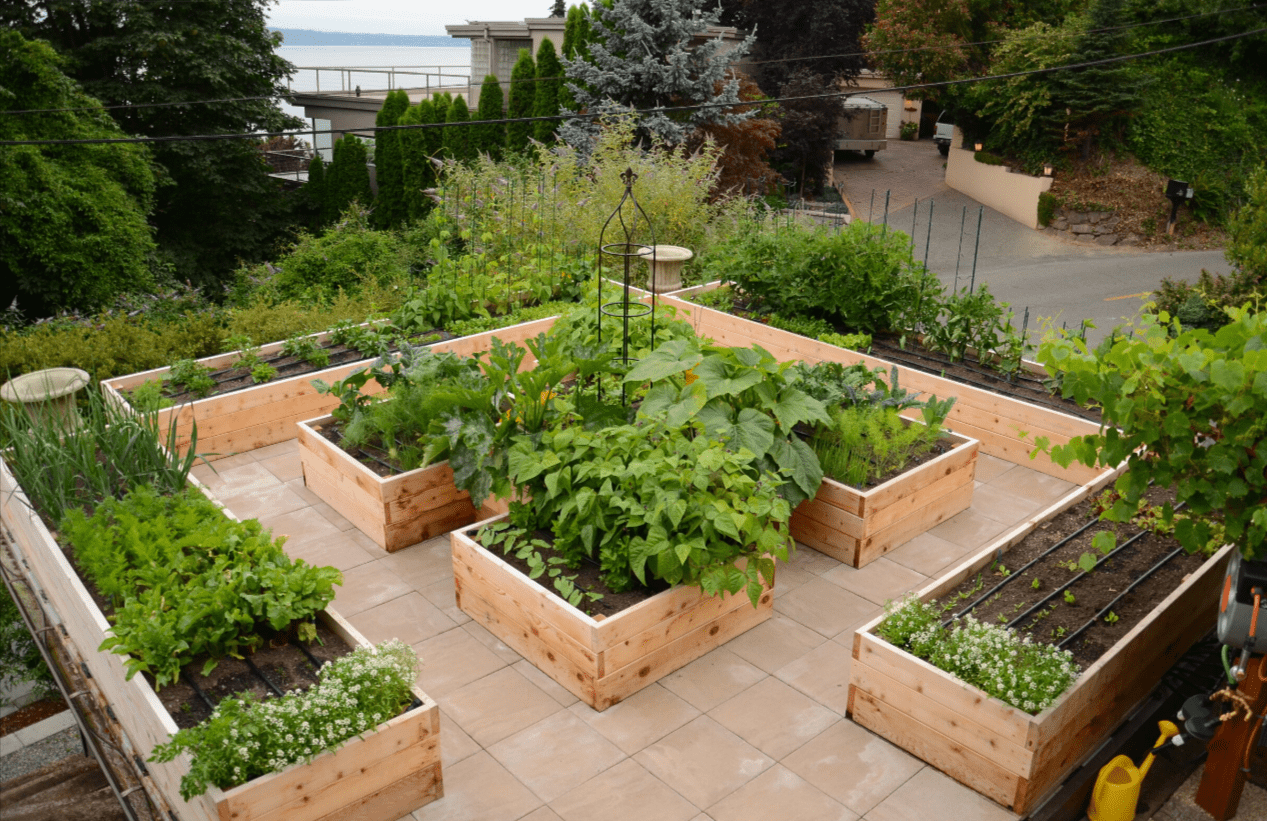15 Reasons to Choose Raised Bed Gardening
Raised Bed Gardening: Whether you’re just starting out or have years of gardening experience, raised beds offer a simpler, more productive, and aesthetically pleasing way to garden. If you’ve been hesitating to invest in them, here are 15 compelling reasons that will persuade you to give raised bed gardening a try!
Optimize Your Soil Health
When gardening directly in the ground, you’re often at the mercy of the existing soil conditions. The soil might be too acidic or too alkaline, overly compacted clay, or loose sand. Erosion could also be a problem. Your soil might lack essential organic matter and nutrients, or, like in my case, you might have to contend with layers of landscape fabric and rock.
Raised bed gardening, however, offers a solution by giving you control over your soil. With raised beds, you can create the perfect environment for your plants by filling them with high-quality soil and enriching it with compost. This allows you to cater to your plants’ specific needs.
Want to grow blueberries? Increase soil acidity with elemental sulfur. Planning to grow sweet potatoes? Use a deep bed filled with loose, nutrient-rich soil.
While it’s possible to improve in-ground soil, it often takes time. Raised beds make it easy to adjust the nutrient levels and fine-tune the growing conditions so your plants can flourish.
Improve Soil Drainage
If you’re dealing with heavy clay soil, you’re probably familiar with how quickly it can become waterlogged. Most plants won’t do well in soggy conditions, which can lead to root rot. Raised beds help address this issue by making it easier to mix in amendments like sand and perlite, which improve water and nutrient movement.
Overwatering is a common cause of gardening issues. Raised beds provide excellent drainage, allowing water to move freely to the roots and drain out the bottom. Generally, the higher the bed, the better the drainage.
On the flip side, sandy soils can have trouble retaining moisture. Completely dried-out soil can leave plants parched and withered. Raised beds make it simple to add compost and mulch to sandy soil, helping it retain moisture and keep your plants hydrated.
Extend Your Growing Season
I sometimes joke that I should take up skiing instead of gardening. In my zone 5b garden, I’m fortunate to get about four months of growing time. The rest of the year, snow and freezing temperatures are the norm.
If, like me, you’re passionate about gardening but live in a region with a short growing season, finding ways to extend that time is a big win. Raised beds can help you start planting earlier in the season because the soil dries out and warms up faster.
In the fall, raised beds make it simple to protect your crops from early frosts using frost cloth or floating row covers. You might even stretch your season further by using a cold frame. By adding just a few weeks at the start and end of the season, you can gain an entire extra month of growing time!
Reduce Physical Stress While Gardening
Although I’m not quite ready to admit I’m aging, a day of gardening in the ground now seems to necessitate a recovery nap. Kneeling on the ground leaves my knees aching, and constant bending over takes a toll on my back. The strain is felt all over.
Raised beds, particularly those designed to be accessible without kneeling, can significantly improve the gardening experience. They’re a game changer for the elderly or those with limited mobility, as you can tend to your plants from a seated position. Harvesting veggies is easier too, without needing to strain your neck.
Planting new crops is effortless in the loose, well-aerated soil of my raised beds, making gardening more accessible. I use various bed shapes and pathways that allow me to reach all my plants with ease.
I occasionally consider adding more in-ground planting areas, but the convenience of raised beds always wins out. If you’re looking to make your garden easier on your body, consider the Rotational 6 in 1 garden bed, which offers multiple configurations for your space, or these tall, stylish beds that are simple to assemble without special tools.
In the meantime, a padded kneeler helps me manage the in-ground beds I’m not ready to part with.
Minimize Weed Growth
Who enjoys weeding? If you’re not one of them, raised beds might be your solution for more productive gardening time by reducing weed pressure. Weeds that spread through rhizomes (looking at you, Bishop’s Weed!) won’t infiltrate the beds, and the fresh, weed-free soil you use to fill them won’t come with a hidden new crop of weeds.
The soil in raised beds is less compacted, richer in nutrients, and allows for denser planting. These conditions make it much less inviting for weeds.
I’m serious when I say that the area around my raised beds and the lawn is overrun with dandelions. I garden organically and steer clear of pesticides and herbicides to protect my kids, pets, and the environment. Interestingly, dandelions don’t seem to grow in the raised beds! Turfgrass, which is a major weed nuisance in my in-ground beds, doesn’t invade my flowers and berry bushes like it does with in-ground planting.
If a rogue weed does appear, it’s easy to spot and remove, unlike the grueling task of managing weeds in traditional garden beds.
Ditch the Tiller
Tilling is still a common practice in agriculture and some home gardens, as it helps loosen compacted, nutrient-poor soil and facilitates the removal of existing plants.
However, tilling can also disrupt soil structure and harm the microorganisms essential for maintaining healthy soil. Raised beds eliminate the need for tilling, as you can easily amend them each year by adding a fresh top layer.
In my raised beds, I don’t pull out plant roots. Instead, I cut off spent plants at the soil level, leaving the roots to decompose naturally. This process enriches and aerates the soil. In the fall, I cover the beds with chopped leaves, and in the spring, I refresh them with a new layer of compost and mulch.
Each year, adding these nutrient-rich layers to your raised beds enhances and revitalizes the soil, improving its structure and microbial activity over time.
Maintain a Polished Garden Aesthetic
I’m drawn to the charm of cottage gardens, with their lush, overflowing borders, wildflower meadows, and winding paths. While I find this style enchanting, it might seem a bit untidy to others.
I let much of my yard develop into a managed, beautiful chaos, but raised beds keep the kitchen garden looking neat and orderly. If you prefer a well-organized space with clean lines, raised beds will be a delight. And if you’re more relaxed about tidiness but still want to avoid upsetting the neighbors, raised beds are a great solution.
Raised beds naturally create a structured area with defined pathways, giving your garden a crisp, neat appearance. They make it easy to achieve a visually pleasing garden. If your lawn is weedy, dry, or patchy, raised beds filled with thriving plants offer an immediate and attractive improvement.
Experiment with different shapes, like L-shaped or circular beds, to achieve your ideal garden look. Place them in the front yard and enjoy the compliments. Raised beds not only enhance gardening but also elevate its visual appeal.
Eliminate Garden Pests
Raised beds simplify the task of keeping pests away from your garden. The height of raised beds helps deter slugs and rabbits, while lining the bottom of the beds with sturdy mesh can keep voles at bay. Plus, dogs can’t lift their legs to pee on your plants.
If you’re dealing with flea beetles or whiteflies, using row covers over your vegetables is a breeze when they’re neatly contained in a raised bed. Although raised bed gardening won’t eliminate pests entirely, it significantly reduces their impact.
Maintain Garden Flexibility
Raised beds offer great adaptability for your gardening needs. If you’re renting, opt for portable and sturdy raised beds that can easily move with you. This setup allows for temporary gardening, so you can maintain your green thumb no matter where you go.
For those with small outdoor spaces like apartment balconies or tiny patios, consider compact raised beds. If relocation is in your future, investing in a traditional in-ground garden may not be practical. Raised beds will ensure you can keep gardening in any situation.
For those in a permanent home, raised beds help mitigate issues like root competition from large trees and shrubs. Position them in areas with ample sunlight (6-8 hours is ideal) to maximize your gardening space effectively.
How to Avoid Soil Compaction
I need to walk on my soil to access the center of my deep, cottage-style pollinator garden for weeding and plant division. However, stepping on the soil, especially when it’s damp, results in compaction.
When soil becomes compacted, it leads to increased water runoff and decreased drainage and oxygenation. As a result, roots struggle more to spread out and access essential nutrients.
Creating pathways between narrow garden beds simplifies plant access without causing soil compression from foot or pet traffic. This keeps the soil loose, enabling better air circulation and water movement. Problem solved!
Manage Aggressive Plants
Have you ever grown mint, kale, or oregano? If so, you’re probably aware that these flavorful and attractive garden staples can become quite unruly. Mint can quickly dominate your garden, kale tends to reseed prolifically, and oregano is another plant that can spread aggressively. Planting these herbs in raised beds helps to manage their growth and contain their spread.
Don’t let their vigorous nature discourage you from growing these beneficial plants. A raised bed will keep them under control! For example, I have a bed with various mint types paired with robust giant sunflowers. In an in-ground garden, these plants could easily become invasive.
Raised garden beds help keep aggressive plants in check, allowing their abundance to appear lush and organized rather than chaotic.
Prevent Soil Contamination
I’m currently helping with an after-school gardening club to set up a garden at a local high school. Just before we started transplanting our seedlings, grounds maintenance sprayed Roundup all over our intended garden area.
The students were understandably disappointed, but there’s a silver lining. In cases like this, raised beds can come to the rescue.
Although planting directly in the ground is no longer an option, we can still utilize the site by keeping our plants out of the contaminated soil. We’re using large containers and donated raised beds, filling them with fresh, clean soil.
Whether your garden is on a former orchard site affected by pesticides or in any area with potential environmental pollutants, raised beds allow you to garden safely. If you’re worried about soil contamination, conduct a soil test, and consider using raised beds, especially for growing food.
Elevate Your Output
One of the key benefits of raised bed gardening is the increased yield. Raised beds enable you to plant more densely, with a higher number of plants per square foot. Since you don’t need to walk on the beds to harvest, you can eliminate the space usually needed for pathways and rows, which helps prevent soil compaction.
With raised beds, you have better control over soil quality and nutrient levels, leading to healthier plants. The loose, well-aerated soil promotes stronger root development and boosts production.
Research shows that using raised beds can enhance yield by 30-50%, depending on the type of crop and growing medium. This can make a significant impact in a small home garden!
Ease Crop Rotation Practices
Pests and diseases thrive when their host plants remain in the same location year after year. Diseases can linger in the soil or on decomposing plant material, ready to reappear in the spring. Pests might lay eggs or pupate in the soil, overwintering to target the same plants the next season.
Crop rotation disrupts this cycle by varying what you plant in each area, preventing pests and diseases from becoming too entrenched.
If you’ve dealt with tomato blight in the past, you can still grow tomatoes, but in a new location where they can start fresh. Avoid planting members of the same plant family in the same spot—no new nightshades in the old tomato bed.
How does this relate to raised beds? They simplify tracking and rotating your crops. Just keep a record of what you plant in each bed to manage your rotation. I use a straightforward sketch of my beds and their layout.
For instance, if I grew tomatoes in a bed last year, I might plant squash there this year. I typically rotate crops every three to four years before returning to the initial plant. This approach creates a manageable rotation system that makes your garden less inviting to pests and diseases.
Reduce Water Usage
Raised beds are effective for conserving water. Traditional lawn sprinklers often water indiscriminately, soaking weeds and bare spots as much as your vegetables. Raised beds let you target water directly to the plant roots where it’s most needed.
Drip irrigation is a more water-efficient option compared to sprinklers and hose wands and is simpler to install in raised beds. Although raised beds may dry out more quickly, the water you use drains efficiently, and organic matter and mulch help improve water retention.
Moreover, overhead watering can promote fungal diseases, as fungal spores thrive on damp leaves, especially in cool, damp conditions. With raised beds, the elevated planting makes it easier to direct water at the roots, reducing the risk of such issues. Overall, raised beds are a smart choice for more efficient water use.
Conclusion
Raised beds enhance gardening by making it simpler and more efficient. They offer the flexibility to garden in any available space, extend the growing season, boost yields, reduce weeds and water usage, and minimize pest and disease issues.
If these advantages aren’t enough to persuade you, consider how much easier your back will feel after a day of gardening. Picture yourself not needing to bend over deeply or kneel to manage weeds. Sounds great, right? Investing in raised beds ensures you can continue gardening, even if you face physical limitations in the future.
Raised beds are a versatile solution. Whether you purchase or build them, you’ll appreciate the benefits they bring to your gardening experience.



